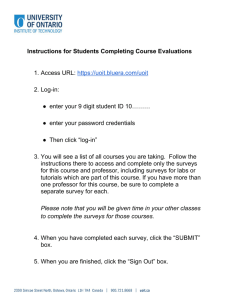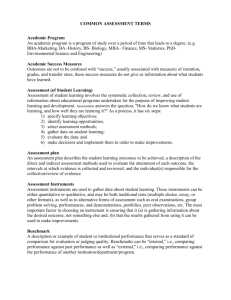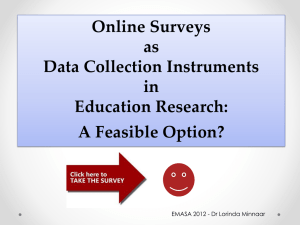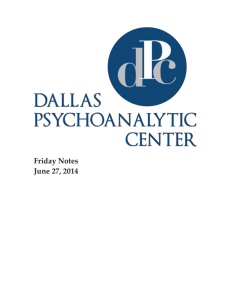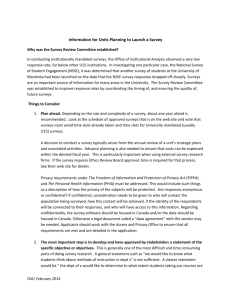Engagement Surveys & Culture Assessment
advertisement
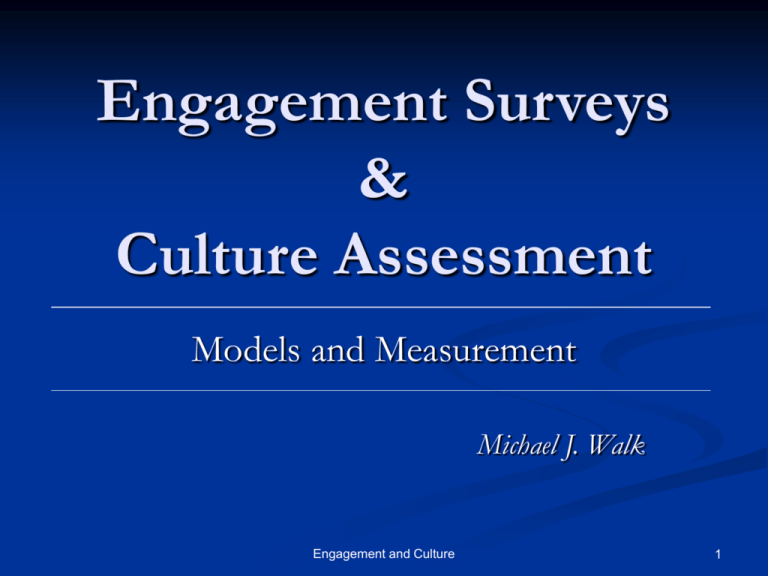
Engagement Surveys & Culture Assessment Models and Measurement Michael J. Walk Engagement and Culture 1 Learning Objectives Define and give examples of employee engagement Define and give examples of organizational culture Explain some of the business outcomes of engagement and culture Explain at least one model of engagement and culture Explain the typical methods used to measure engagement and culture Engagement and Culture 2 Employee Engagement Engagement and Culture 3 Definitions Scholarly background: Kahn (1990): “the simultaneous employment and expression of a person’s ‘preferred self ’ in task behaviors that promote connections to work and to others, personal presence,…and active, full performances” Engagement and Culture 4 Definitions Current Definitions “A positive, fulfilling, work-related state of mind that is characterized by vigor, dedication, and absorption.” (Encyclopedia of Industrial/Organizational Psychology) “The level of commitment and involvement an employee has toward their organization and its values.” (AlphaMeasure) “Engagement is the state of emotional and intellectual involvement that employees demonstrate at work.” (Hewitt Associates) Engagement and Culture 5 What Engagement ISN’T Employee Satisfaction: only deals with how employees feel about their current environments Organizational Commitment: only deals with employees’ desires to stay Engagement and Culture 6 Behaviors & Outcomes of Engagement Increased performance More likely to treat customers in ways that positively influence customer satisfaction Willing to give extra effort when needed Improves customer loyalty through improving the service climate (Agut & Peiró, 2005) Engagement and Culture 7 Bottom-Line Outcomes Source: Towers Perrin Engagement and Culture 8 More Outcomes High job-satisfaction Low absenteeism Increased loyalty Lower costs of recruiting, hiring, training, developing Engagement and Culture 9 Consequences of Disengagement Disengaged employees Miss an average of 3.5 more days per year Less productive / Diminished performance Lower morale High turnover = Training dollars lost Cost the US economy $292 to $355 billion per year (Financial News, March 2001) Engagement and Culture 10 Current Levels of Engagement (2003) Gallup conducted international survey measuring employee engagement Engagement and Culture 11 Current Levels of Engagement (2) France: Disengaged workforce (31%) costs between 79 – 104 billion Euros annually! At today’s exchange: $109 - $144 billion USA: 27% are actively engaged, 17% disengaged Engagement and Culture 12 Models of Engagement No Universal Model of Engagement Some plausible options include: 3-Behaviors 3-Modes 3-Needs 3-Concepts Engagement and Culture 13 Models of Engagement (1) 3 Behaviors (Hewitt Associates, AlphaMeasure) Say: Consistently speak positively about the organization to coworkers, potential employees, and customers Stay: Have an intense desire to be part of the organization Strive: Exert extra effort and engage in behaviors that contribute to business success Engagement and Culture 14 Models of Engagement (2) 3 Modes (Towers Perrin) Cognitive (think): Logical evaluation of the company’s goals and values. Affective (feel): Whether employees have a sense of belong and pride in the company. Behavioral (act): Retention, willingness to “go the extra distance.” Engagement and Culture 15 Models of Engagement (3) 3-Tiered Structure of Needs (Accord Management) Basic: fundamental to job Intermediate: growth and development needs safety, team, competent supervisor, tools/equip, basic skills, valued, respected, fair, enjoy work development, encouragement, sense of belonging, personal fulfillment, adequate compensation Advanced: org commitment needs customer focus, org growth and success, value diversity, belief in compete strategy Engagement and Culture 16 Models of Engagement (4) 3-Part Conceptual Model (Schaufeli, Salanova, Gonza´lez-Roma´, & Bakker, 2002) Vigor refers to high levels of energy and mental resilience while working, the willingness to invest effort in one’s work, and persistence even in the face of difficulties. Dedication is characterized by a sense of significance, enthusiasm, inspiration, pride, and challenge at work. Absorption consists of being fully concentrated, happy, and deeply engrossed in one’s work whereby time passes quickly, and one has difficulty detaching oneself from work. Engagement and Culture 17 Measuring Engagement Model-contingencies Measurement will vary depending on subscribed model. Most (if not all) measures are surveys/questionnaires Engagement and Culture 18 Examples of Measures Gallup’s Q12 12 items Found to be predictive of business outcomes Hewitt Associates 6 items Several other organization-specific instruments Often accessible online Engagement and Culture 19 Using the 3-Concept Model Work Engagement Scale (Schaufeli, Salanova, Gonza´lez-Roma´, & Bakker, 2002) 17 items 6 items for Vigor 5 items for Dedication 6 items for Absorption Engagement and Culture 20 Let’s Try It for Ourselves Get into groups Chose one of the models Create 3 – 5 items 3-Behavior (say, stay, strive) You have 5 minutes 3-Mode (act, feel, think) 3-Needs (basic…advanced) 3-Concepts (vigor, dedication, absorption) Engagement and Culture 21 Engagement Summary Many definitions – enjoyment of and attachment to work and organization Valid construct – research links engagement to important business outcomes Many models – apply to different contexts and organizations Measurement – done through surveys; multiple instruments Engagement and Culture 22 Culture Assessment Engagement and Culture 23 Definitions “Refers to the shared meaning, interpretations, and understanding of various organizational events among organizational members. Serves as a guide to members to behave in ways shown to be effective over time; adds a sense of predictability and order to uncertainties in the environment; and provides a general understanding of how, when, and why members behave in certain ways.” (Encyclopedia of I/O Psychology) Engagement and Culture 24 Models of Culture Denise Rousseau Multi-layered concept ranging from most accessible to least accessible. Material Artifacts Behavioral Patterns Behavioral Norms Values / Beliefs preferences for various the basic, fundamental provide predictability routinized activities thatamong buildare outcomes or behaviors assumptions that typicallyand exist logos, layouts, etc. members and identify coordination generally conscious awareness or espoused outside of conscious acceptable and unacceptable by organizational members behavior Assumptions Engagement and Culture 25 Assumptions? Edgar Schein (1992) A pattern of basic, largely unconscious assumptions that organizational members share. These assumptions are learned over time as those behaviors effective at solving organizational issues with adapting to the external environment or with resolving internal conflict that have become to be internalized as the right way to do things here. Engagement and Culture 26 Models of Culture (2) VIT Industrial Systems (Finland) Culture: “a solution created by an organization for the demands set by the core task,” (Reiman, 2001; Reiman, & Norros, 2002). Core Task: “the essential content of some job or duty” Engagement and Culture 27 Models of Culture (2) VIT Industrial Systems Engagement and Culture 28 Measuring Culture Model-contingencies Measurement will vary depending on subscribed model. Surveys / Questionnaires Qualitative Methods Engagement and Culture 29 Culture Instruments Classified Into Two Types Typing Surveys: classify organizations into mutually exclusive taxonomies (similar to MBTI), provide examples of typical cultures that match scores. Profile Surveys: assess organization on predetermined cultural dimensions. Engagement and Culture 30 Exercise on Types Academy: • highly skilled, tend to stay, work up ranks, stable environment (e.g., universities, hospitals) Baseball Team: •free agents—highly prized skills, high demand; fast-paced, high-risk (e.g., investment banking, advertising) Club Culture: •fit into the group; start at bottom and stay; promote from within (e.g., military, law firms) Fortress: Source: Carter McNamara •uncertain job security, massive reorganizations, opportunities for those with specialized skills (e.g., savings and loans, car companies, etc.) Engagement and Culture 31 Instruments – Typing Surveys Organizational Culture Assessment Instrument (OCAI) Cameron & Quinn (1999) Types of Culture: Hierarchy Culture Market Culture Clan Culture Adhocracy Culture Dimensions of Culture: Engagement and Culture Dominant Characteristics Organizational Leadership Management of Employees Organizational Glue Strategic Emphasis Criteria for (judging) Success 32 Instruments – Typing Surveys Organizational Culture Inventory (OCI) (Cooke & Lafferty, 1983) – published by Human Synergistics Types of Culture: Constructive Passive-Defensive Aggressive-Defensive 12 Normative Beliefs: Humanistic-Encouraging Affiliative Approval Conventional Dependent Avoidance Engagement and Culture Oppositional Power Competitive Perfectionistic Achievement Self-Actualizing 33 Research with OCI Found that Constructive cultures have higher: member satisfaction, commitment, motivation, role clarity, intent to stay group teamwork, unit-level quality organizational quality of service, safety and reliability, customer satisfaction, voluntary turnover, sales, profitability Engagement and Culture 34 Instruments – Other Resources Organizational Culture Instrument (van de Post & de Coning, et al., nd) Organizational Culture Survey (Glaser, Zamanou, & Hacker, 1987) 15 dimensions of culture (e.g., customer orientation, task structure, goal clarity, etc.) 6 components (e.g., teamwork-conflict, information flow, etc.) Schweiger-Larkey Organizational Culture Index (SLOCI©) 15 dimensions of culture (e.g., centralized vs. decentralized, conflict avoidance vs. conflict confrontation, etc.) Engagement and Culture 35 Qualitative Methods Document Analysis Critical Incidents Interviews / Focus Groups (e.g., Yauch & Steudel, 2003) Observations Seminars / Workshops Engagement and Culture 36 Mixed Methods (VIT Industrial) Contextual Assessment of Organizational Culture The development of an organization’s operations requires an understanding of the overall dynamics (culture) of the organization’s activities, but also an assessment of the impact of culture on operational efficiency, which must be assessed on a case-by-case basis. Core-Task Analysis studies and assesses work’s essential content and its critical demands how the demands manifest themselves in daily work what effect new content (e.g., pressures for change from environment) has on core task Engagement and Culture 37 Mixed Methods - Triangulation Best to combine quantitative instruments with qualitative methods For example, Yauch & Steudel (2003) did all of the following: 1. 2. 3. 4. 5. 6. Document review Observation of meetings and workplaces Group interviews with several levels Administered OCI Member checks to insure findings met member’s impressions Third-party audit Engagement and Culture 38 Culture Summary Many definitions – the beliefs, values, and norms generated out of an organization’s specific environment and context Theoretical concept – gaining new place in scholarly research Many models – apply to different contexts and organizations Measurement – done through surveys and qualitative methods Engagement and Culture 39 What are your questions? Engagement and Culture 40



